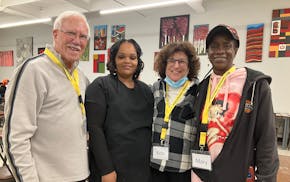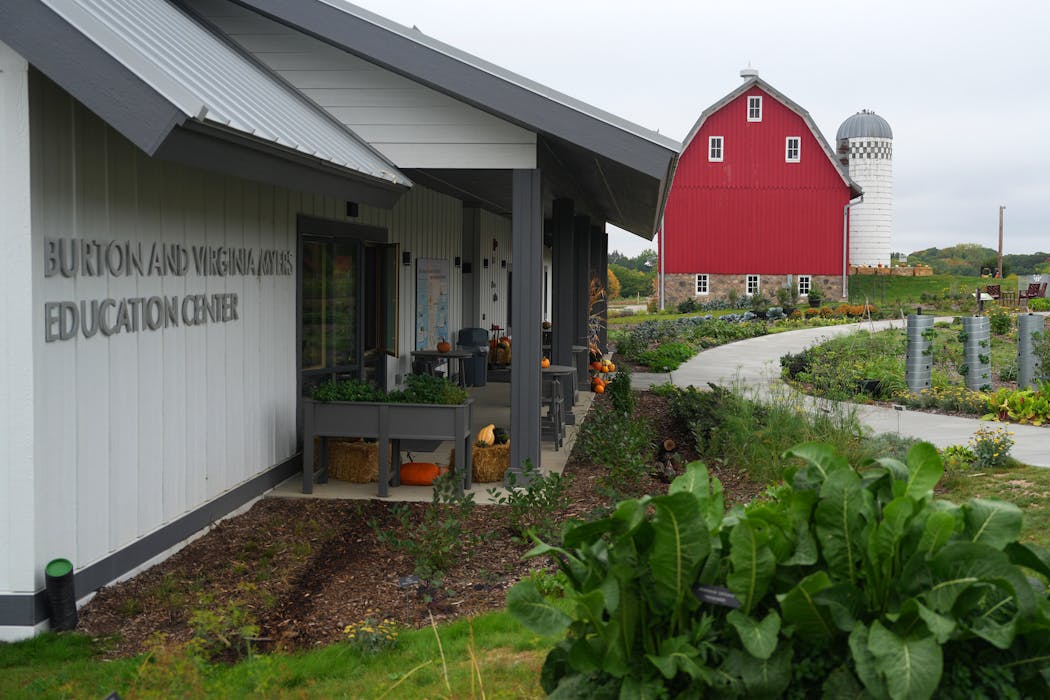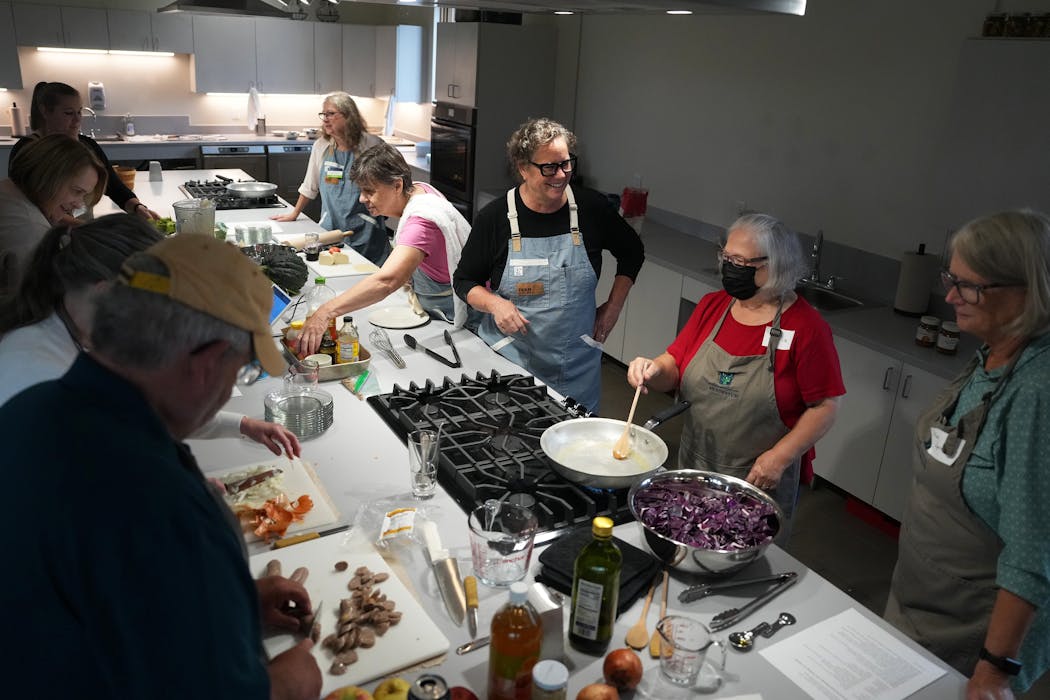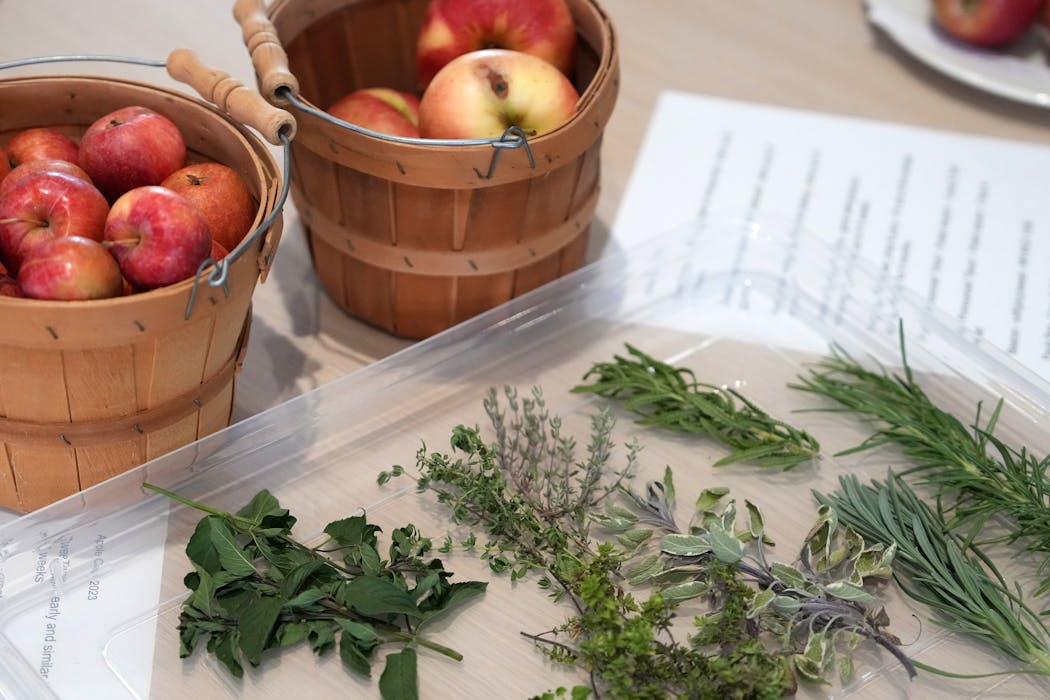Even the rain falling on the grounds of the Minnesota Landscape Arboretum couldn't dampen Beth Fisher's enthusiasm.
Through the mist, the historic red barn stood tall on the bucolic but bustling Farm at the Arb, which hugs the edge of the arboretum's property. The farm boasts a pollinator center, edible gardens, agricultural plots, a foodscapes garden, a summer kitchen, displays and interactive exhibits — all bringing the state of Minnesota agriculture to life.
The centerpiece is the Myers Education Center, where Fisher, a longtime Twin Cities chef, is already right at home. As the Farm at the Arb's new culinary programmer and instructor, she beams as she walks through the state-of-the-art kitchen and classroom.
"They call it the hearth of the farm because the biggest thing is this classroom, and it's a full circle seed-to-table," Fisher said.
Those who have followed Fisher's culinary career know this job wasn't a big leap. She's taught classes throughout the Twin Cities for years, and her résumé is flush with farm-to-table experience, from her role as chef de cuisine at the groundbreaking Lucia's to opening restaurants like Wise Acre Eatery, Thirty Bales, Rustica, French Meadow and, most recently, Kruse Markit.
How she landed at the arb had something to do with serendipity, but more to do with Fisher's willingness to embrace a new challenge that married her passions for cooking and gardening.
"It's a good time for me to join and, let me tell you, I had my reservations," said Fisher. "I'm 59 years old and I was like, 'Really? I'm jumping back into another big project?' " But she added, "I've been known to bounce around. That just keeps me having fun and doing what I love — creating food and enjoying life."
We joined Fisher to talk about her start as a popover girl, her plans for filling the arb's culinary calendar and how restaurants talk to you.
How she became interested in a career in food:
"I graduated from Minnetonka High School and went to the University of Minnesota, and there's where I got interested in food. Some of the managers from Winfield Potters came into my sorority and wanted to know if anybody wanted to work there on weekends. So, I was the popover girl on the weekends. That's really how it all started. I was like, 'I really like this.' "
When she knew she was hooked:
"I grew up with three older brothers, and there were a lot of guys in the kitchens. I really enjoyed the camaraderie and they encouraged me to keep going. So, I took a job at Chessen's [Deli in Minneapolis], right by the courthouse, and learned my speed on the line — we were doing 250, 300 lunches at the time. I just fell in love with it and never left it."
When she started teaching:
"While I was at Lucia's, I started teaching at Kitchen Window, and taught there on and off for 15 years. I really, really loved teaching — just seeing the light bulbs go off. I still get people who stop me and say, 'Are you Beth? I still cook some of your appetizers. I'm like, thank you so much.' "
On landing at the Arboretum:
"It's very serendipitous. I got to take COVID off, basically, and worked on my house a lot and was able to take step back from restaurant running and cheffing, and decided that I wanted to focus on gardening. I love to garden."
She applied for temporary summer position at the Arboretum — and didn't get it. "But I got a call from Tim Kenny [the arboretum's director of education], and he said, 'I pulled your résumé out, would you have time to chat with me?' I still couldn't find much information on Farm at the Arb, and didn't really understand what it was. Then I came out here and I was just like 'Oh my goodness, what is this?' "
On combining her two passions:
"[Kenny] wanted me to teach classes — 10, 20 as many as I wanted. He said we're just trying to get a curriculum going, we're trying to get people out here. So I thought about it, and in the meantime, he had just lost his part-time chef who had been here for a very long time. So he said 'I have a bigger opportunity if you want to take the culinary lead.' I really never thought I could teach again, that the opportunity would arise. My wife looked at me and said, 'You're not even considering not taking this, right?' "
On planning her curriculum:
Expect Fisher to draw on old friends and connections to help fill the culinary calendar, including author Beth Dooley. "She's just unbelievably smart and connected to the world, so she and I are going to do Beth and Beth classes. I would love to bring the chef series back, and for people to come out from all over the state and cook here. The sky's the limit right now. We have this beautiful space, we have this beautiful farm around us, and we have such support."
On drawing from her new colleagues:
"A horticulturist said he would love to do an invasive species class, like nettles and snake roots. I said 'That's cool, I know nothing about that, but I'll be your sous chef and we can do some really fun things.' You're either a foodie or you're not, and if you're a foodie, to get into the kitchen and have fun is what it's all about."
On planning ahead:
"This year, we're going to throw a bunch of things a the wall and see what goes. Next year will be a big trial year. We want to see what classes people are interested in and what the feedback is. It's like a restaurant — you have to let it talk to you. You have to let it tell you what it wants."
On her the vision:
"To educate people on agriculture and cooking out of their gardens and farmers markets — and to enjoy cooking. I think that's been huge because of COVID, and the pandemic definitely put people back in their kitchens. People are hungry for more ideas and to have more fun in the kitchen. So my pie in the sky is that we can fill our classroom five to seven days a week with fun activities that teach people new things and to look at things differently."
About Farm at the Arb
Where: 3210 W. 82nd St., Chanhassen, arb.umn.edu/farmatthearb
Hours: 9 a.m.-6 p.m., but changes seasonally
Cost: Included with the Arboretum's general admission ticket ($15 for adults 16 and older, free for 15 and younger).
Take a class: For a list of upcoming classes, go to arb.umn.edu/learn
Stay in the loop: Be alerted to upcoming classes and programs, sign up at z.umn.edu/chef-beth
Italian Sausage with Delicata Squash, Garden Pesto and White Beans
Serves 3 to 4.
Note: No need to peel the thin-skinned delicata squash. Top this dish with lemon wedges, torn basil and serve with crusty bread and dinner is ready to enjoy. From Beth Fisher.
• 1 delicata squash, washed (see Note)
• 1 tbsp. olive oil
• 1/2 tsp. salt
• 1/4 tsp. black pepper
• 3/4 c. chicken or vegetable broth, divided
• 1 lb. fresh bulk Italian sausage
• 1 (15-oz.) can white beans, drained and rinsed
• 2 tbsp. basil pesto, homemade or store-bought
• 2 tbsp. butter
• 1 medium lemon, zested
• 1 medium lemon, cut in halved
• 2 oz. Parmesan cheese, shredded
• Salt and pepper, to taste
• Torn basil leaves and lemon wedges, for optional garnish
Directions
Cut the ends off the squash. Slice the squash lengthwise, scoop out seeds, cut into 1-inch half-moons and toss in a bowl with olive oil, salt and pepper.
Heat a 10-inch skillet over medium-low heat. Place the squash half-moons into the preheated skillet, arranging cut side down. Brown 3 to 4 minutes and then flip over and brown the other side 2 to 3 minutes more.
Add 1/4 cup of broth to the pan and cover tightly for 4 minutes. Remove squash, put in a bowl and cover to keep warm.
Wipe the skillet dry and cook sausage, breaking it up into a nice big crumble. Once sausage has cooked through, add the beans, the remaining 1/2 cup broth and bring the mixture to a boil for 3 to 5 minutes.
Reduce heat and add the pesto, butter and lemon zest, and squeeze the lemon halves right into the skillet.
Stir it all together and taste, adding salt and pepper as desired.
To serve, divide the sausage, white bean and pesto into the bottom of warmed flat-bottomed bowls. Spoon browned squash over mixture and add a generous sprinkle of Parmesan cheese. Garnish with lemon wedge and torn basil, if desired, before serving.
Apple Mini Pies
Makes 8 double-crust mini pies.
Note: For depth of flavor, it's best to bake with a mix of tart and sweet apples. Chef Beth Fisher's go-to for apple pie is a combination 1 part Haralson and 3 parts Honeycrisp apples. Both are midseason apples and are currently available at the AppleHouse run by the Arboretum.
For the crust:
• 2 1/2 c. all-purpose flour
• 2 tbsp. sugar
• 1 tsp. salt
• 1 c. (2 sticks) butter, unsalted, chilled and cut into cubes
• 1/2 c. plus 2 tbsp. cold water
For the filling:
• 4 c. diced apples, cored and peeled, if desired (see Note)
• 1 tbsp. butter
• 2 tsp. fresh lemon juice
• 1 tsp. pumpkin spice
• 1/4 c. sugar
For assembly:
• 1 egg
• 1 tbsp. water
• 1/2 c. sugar for sprinkling on pies
Directions
To prepare the crust: In the bowl of a food processor, combine flour, sugar, salt and chilled, cubed butter. Pulse the mixture a couple of times and then, with the motor running, pour in 1/2 cup cold water, allowing the motor to run until the mixture looks like it's just coming together.
Add the extra 2 tablespoons of water to get the dough hydrated enough to form a dough ball. You do not want to over process this dough. (It's OK to bring it together by hand, too.)
Divide dough in half, then into quarters and then divide each quarter into 4 equal pieces.
Roll the 16 pieces into balls and place them in a pie plate, cover and refrigerate at least 1 hour or overnight. You could also freeze the dough for up to a month.
To prepare the filling: Melt butter in a large skillet over medium-high heat. Add diced apples, sugar, lemon juice and pumpkin spice and gently cook, stirring frequently, for 3 to 5 minutes. Allow the mixture to cool before filling mini pies.
To assemble: When you're ready to make the hand pies. Preheat oven to 400 degrees. Line a baking sheet with parchment paper.
Working on a floured surface, roll out each ball to a 4-inch round that is 1/4 inch thick. You should now have 8 tops and 8 bottoms. Whisk together 1 egg and 1 tablespoon of water. Working one pie at a time, brush egg wash around the edge of crust, going in about 1 inch. Place 1/3 cup of apple filling mixture in the middle and top with another round of dough.
Roll edges and pinch together around the apple mixture to seal well. Cut a couple decorative steam vents into each mini pie and place each raw pie on a lined baking sheet, continuing until you have 8 mini apple pies.
Bake pies in the center rack of the oven for 20 to 25 minutes, until golden brown. (This may take longer, depending on your oven and dough thickness.
Allow to cool, but serve warm with (optional) whipped cream, ice cream and/or caramel drizzle.

Review: Sierra Ferrell wows sold-out First Avenue with her refreshingly quirky country sounds

Plant sales: A perennial favorite for great bargains and great gardening advice
News anchor Poppy Harlow announces departure from CNN
Orange crush: Boats packed with revelers tour Amsterdam canals to celebrate the king's birthday





